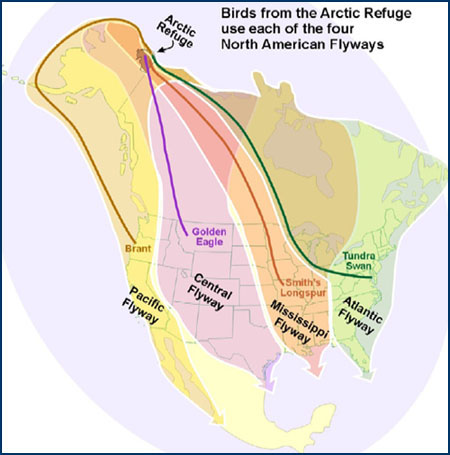Arctic Slope, AK
Arctic Slope and Arctic National Wildlife Refuge
From http://www.fws.gov/refuges/profiles/index.cfm?id=75600
Renowned for its wildlife, the Arctic National Wildlife Refuge is inhabited by 45 species of land and marine mammals, ranging from the pygmy shrew to the bowhead whale. Best known are the polar, grizzly, and black bear; wolf, wolverine, Dall sheep, moose, muskox, and the animal that has come to symbolize the area's wildness, the free-roaming caribou. Thirty-six species of fish occur in Arctic Refuge waters, and 180 species of birds have been observed on the refuge.
Eight million acres of the Arctic Refuge are designated Wilderness, and three rivers (Sheenjek, Wind, and Ivishak) are designated Wild Rivers. Two areas of the refuge are designated Research Natural Areas. Because of distinctive scenic and scientific features, several rivers, valleys, canyons, lakes, and a rock mesa have been recommended as National Natural Landmarks.
Perhaps the most unique feature of the refuge is that large-scale ecological and evolutionary processes continue here, free of human control or manipulation. A prominent reason for establishment of the Arctic Refuge was the fact that this single protected area encompasses an unbroken continuum of arctic and subarctic ecosystems. Here, one can traverse the boreal forest of the Porcupine River plateau, wander north up the rolling tiaga uplands, cross the rugged, glacier-capped Brooks Range, and follow any number of rivers across the tundra coastal plain to the lagoons, estuaries, and barrier islands of the Beaufort Seas coast, all without encountering an artifact of civilization.
The refuge encompasses the traditional homelands and subsistence areas of Inupiaq Eskimos of the arctic coast and the Athabascan Indians of the interior.
Bird Migration Routes
From http://arctic.fws.gov/birdmig.htm
Many North American birds come to the far northern regions of the continent in summer to reproduce and raise their young. Long summer days in the north produce an abundance of insects and plants for birds and their young to eat. Because this food is not available during
cold, winter months, many birds migrate south to forage in warmer climates.
 These birds follow migratory routes, called flyways, between their northern breeding grounds and southern wintering areas. There are four major flyways in North America: the Pacific, Central,
Mississippi and Atlantic Flyway.
These birds follow migratory routes, called flyways, between their northern breeding grounds and southern wintering areas. There are four major flyways in North America: the Pacific, Central,
Mississippi and Atlantic Flyway.
Maps of these flyways often show only the central portion of the North American continent. These maps provide no information about more northern areas. The large map shows how portions of all four flyways overlap in the Arctic Refuge. This overlap connects the Refuge to bird-wintering areas throughout Canada, the lower 48 states and beyond.

The Refuge’s information sheet titled “Which birds may travel from the Arctic Refuge to or through your area?” shows that birds breeding on the Arctic Refuge have ranges that reach all 50 states. It is available at http://arctic.fws.gov/birdpost.htm. Birds follow routes in all four flyways as they migrate between the Arctic Refuge and their southern wintering areas
(An animated version of this map is available on the web at http://arctic.fws.gov/birdmig.htm.)
 Join In
Join In Archives
Archives